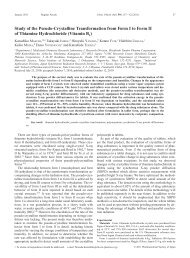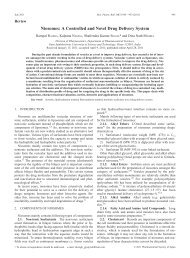High-Frequency Genetic Contents Variations in Clinical
High-Frequency Genetic Contents Variations in Clinical
High-Frequency Genetic Contents Variations in Clinical
Create successful ePaper yourself
Turn your PDF publications into a flip-book with our unique Google optimized e-Paper software.
May 2011 625<br />
U.S.A.). Cl<strong>in</strong>ical isolates were obta<strong>in</strong>ed from Changhai Hospital<br />
of Shanghai, Ch<strong>in</strong>a.<br />
All samples were ma<strong>in</strong>ta<strong>in</strong>ed as 80 °C stocks <strong>in</strong> 30%<br />
glycerol. All isolates were cultivated <strong>in</strong> YEPD (1% yeast extract,<br />
2% peptone, 2% glucose) at 30 °C, with 200 rpm agitation.<br />
Genotyp<strong>in</strong>g Analysis Polymerase cha<strong>in</strong> reaction (PCR)<br />
for MTL status and the ribosomal RNA (rRNA) gene transcribed<br />
spacer region was done as previously described. 19)<br />
DNA Isolation C. albicans isolates stored at 80 °C<br />
were streaked on a Sabouraud agar plate. After <strong>in</strong>cubation<br />
overnight at 30 °C, several colonies were collected and<br />
<strong>in</strong>oculated overnight <strong>in</strong> 5 ml YEPD medium at 30 °C, harvested<br />
and washed with distilled water, resuspended <strong>in</strong><br />
200 ml lysis buffer (2% Triton X-100, 1% sodium dodecyl<br />
sulfate (SDS), 100 mM NaCl, 1 mM ethylenediam<strong>in</strong>etetraacetic<br />
acid (EDTA), 10 mM Tris, pH 8.0). DNA was isolated<br />
as described by Hoffman and W<strong>in</strong>son. 20) DNA was purified<br />
us<strong>in</strong>g the PCR Clean-up NucleoSp<strong>in</strong> Extract II Kit<br />
(Macherey-Nagel, Germany) accord<strong>in</strong>g to manufacturer’s<br />
<strong>in</strong>structions.<br />
Microarray Production For the production of spotted<br />
DNA-microarrays, 7925 70 mer oligonucleotides target<strong>in</strong>g<br />
the ORFeome of C. albicans were pr<strong>in</strong>ted triplicate on am<strong>in</strong>o<br />
silaned glass slides us<strong>in</strong>g a SmartArrayer TM microarrayer<br />
(CapitalBio Corp.). Prior to hybridization, the slides were<br />
rehydrated over 65 °C water for 10 s, UV cross-l<strong>in</strong>ked at<br />
250 mJ/cm 2 .<br />
DNA Label<strong>in</strong>g for Array CGH Analysis The generation<br />
of DNA fragments by sonication was performed with<br />
10 mg buffered DNA sample. For each label<strong>in</strong>g reaction,<br />
3.5 mg of fragmented DNA and 4 mg of random nonamer<br />
were heated to 95 °C for 3 m<strong>in</strong> and snap cooled on ice, then<br />
10Klenow buffer, dNTPs and Cy5-dCTP or Cy3-dCTP<br />
(GE HealthCare) were added at f<strong>in</strong>al concentrations of<br />
120 m M each dATP, dGTP, dTTP, 60 m M dCTP and 40 m M Cydye,<br />
respectively. Klenow enzyme (1 ml, Takara, Dalian,<br />
Ch<strong>in</strong>a) was added and reaction was performed at 37 °C for<br />
1 h. The labeled DNA was purified with a PCR Clean-up NucleoSp<strong>in</strong><br />
Extract II Kit. All samples had dye-swap replicates<br />
to remove any dye bias.<br />
Microarray Hybridization, Scann<strong>in</strong>g and Data Process<strong>in</strong>g<br />
For array CGH, the labeled control and test samples<br />
were mixed <strong>in</strong>to 80 ml hybridization solution (3SSC, 0.2%<br />
SDS, 50% formamide). DNA <strong>in</strong> hybridization solution was<br />
denatured at 95 °C for 3 m<strong>in</strong> prior to load<strong>in</strong>g on the microarray.<br />
The arrays were hybridized at 42 °C overnight and<br />
washed with two consecutive wash<strong>in</strong>g solutions (0.2% SDS,<br />
2SSC for 5 m<strong>in</strong> at 42 °C and 0.2% SSC for 5 m<strong>in</strong> at room<br />
temperature). Two types of arrays were performed under the<br />
same experimental conditions; one was a normal array (reference/reference<br />
hybridization) and the other test arrays (reference/test<br />
hybridization).<br />
Arrays were scanned with a confocal LuxScan TM scanner<br />
(CapitalBio Corp.), and the data of obta<strong>in</strong>ed images were<br />
extracted with LuxScan 3.0 software (CapitalBio Corp). A<br />
spatial and <strong>in</strong>tensity-dependent normalization based on a<br />
LOWESS program was employed. 21) The normalized log 2<br />
(test/control) ratio of signal <strong>in</strong>tensity was considered as a<br />
measure of the relative abundance of each gene relative to<br />
that of the reference isolate SC5314. We used CGH-M<strong>in</strong>er<br />
for statistical analysis of DNA copy number ga<strong>in</strong>s and<br />
losses. 22) CGH-M<strong>in</strong>er uses a “Cluster Along Chromosomes<br />
(CLAC)” algorithm, which builds a hierarchical cluster-style<br />
tree along each chromosome (or chromosome arm), and the<br />
neighbor<strong>in</strong>g genes with positive and negative ratios are separated<br />
<strong>in</strong>to different clusters. Ga<strong>in</strong>s and losses are then called<br />
significantly based on the height and width of clusters, and a<br />
false discovery rate (FDR) is estimated by comparison to<br />
normal–normal hybridization data. Consensus FDR, which is<br />
an estimator of the consensus result of the ga<strong>in</strong>/loss across all<br />
samples, is also calculated. For data smooth<strong>in</strong>g, the parameters<br />
were set for BAC analysis, to produce a mov<strong>in</strong>g w<strong>in</strong>dow<br />
of three ORFs for averag<strong>in</strong>g the hybridization signal. 18) And<br />
the cluster tree was built on whole chromosomes.<br />
Variable genes identified by array CGH were validated by<br />
quantitative real-time PCR (qPCR) us<strong>in</strong>g 7500 Real Time<br />
PCR system (Applied Biosystems) and SYBR Green I<br />
(Takara Bio, Tokyo, Japan). The DNA copy number of the<br />
variable genes was determ<strong>in</strong>ed relative to the gene TDH3<br />
(orf19.6814), a reference gene that array CGH showed not to<br />
vary <strong>in</strong> all the cl<strong>in</strong>ical isolates. We used the comparative Ct<br />
method (2 DDCt ) to determ<strong>in</strong>e target gene copy number <strong>in</strong> the<br />
test isolates relative to the reference gene and the reference<br />
DNA sample of SC5314. 23,24)<br />
Raw data have been deposited <strong>in</strong> NCBIs Gene Expression<br />
Omnibus (GEO) and are accessible through GEO series<br />
accession number GSE18819. Functional annotations and<br />
GO term association was done follow<strong>in</strong>g Candida Genome<br />
Database (CGD) annotations.<br />
RESULTS<br />
Characterization of Isolates A total of eight C. albicans<br />
isolates were isolated from eight different patients<br />
attend<strong>in</strong>g the same hospital <strong>in</strong> the year 2006 (Table 1). All<br />
the test isolates and the reference isolate SC5314 were ma<strong>in</strong>ta<strong>in</strong>ed<br />
on Sabouraud agar plates at 4 °C or as 80 °C stocks<br />
<strong>in</strong> 30% glycerol. Initially, the isolates were streaked for <strong>in</strong>dependent<br />
colonies on CHROMagar medium (CHROMagar<br />
Company, Paris, France) and <strong>in</strong>cubated, as recommended by<br />
manufacturer. If the green color of the colonies <strong>in</strong>dicated<br />
C. albicans, we then performed, <strong>in</strong> addition, polymerase<br />
cha<strong>in</strong> reaction (PCR) with primers that amplified the ITS1<br />
region of ribosomal DNA (rDNA), which also designated the<br />
ATP-b<strong>in</strong>d<strong>in</strong>g cassette (ABC) type of each isolate (ABC<br />
type). 19) ABC typ<strong>in</strong>g revealed that isolates SC5314, U885,<br />
S204 and S727 were of genotype A, isolates F32, S241 and<br />
S9-04 were of genotype B, and the rest two isolates (P546,<br />
S197) were of genotype C (data not shown).<br />
Statistical Analysis of Array CGH Data We estimated<br />
the DNA content of each of eight cl<strong>in</strong>ical isolates with array<br />
CGH approach, as compared to a control sequenc<strong>in</strong>g stra<strong>in</strong><br />
SC5314. Every microarray conta<strong>in</strong>ed 19056 probes represent<strong>in</strong>g<br />
6111 ORFs of SC5314 (Materials and Methods). We<br />
calculated the DNA content of every gene, as the ratio<br />
test/control and, subsequently, averaged the six values correspond<strong>in</strong>g<br />
to six data po<strong>in</strong>ts (Materials and Methods). Furthermore,<br />
we used CGH-M<strong>in</strong>er for statistical analysis of<br />
DNA copy number ga<strong>in</strong>s and losses (Materials and Methods).<br />
In order to determ<strong>in</strong>e if the differences <strong>in</strong> hybridization<br />
efficiency were due to divergence of the DNA sequence, we




